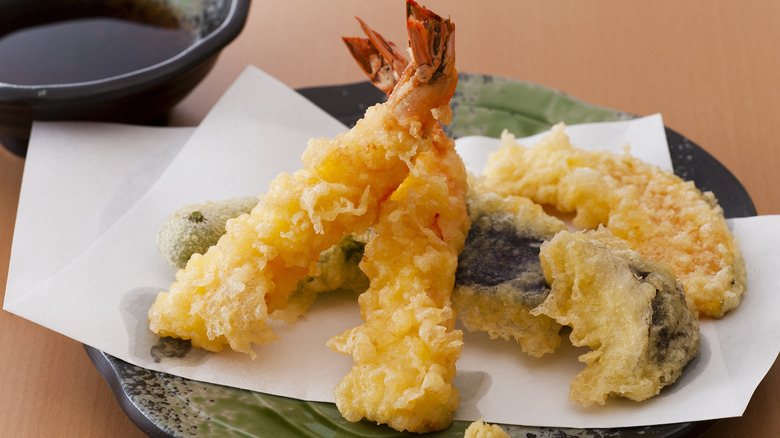The Oil You Should Be Using For Tastier Tempura
Tempura, the Japanese technique of deep-frying proteins, vegetables, and more, is all about creating crispiness and a delicate flavor. Fried tempura batter's irresistible crunch lends itself perfectly to a number of dishes, including the classic shrimp or vegetable tempura found at most Japanese restaurants. It can even be used to create delicious, outside-the-box creations like Tempura Fried Greens. At first glance, making homemade tempura might seem daunting, but if you know the right methods beforehand, it's incredibly simple.
Tempura batter absorbs an oil's flavor, which can make or break your dish. The best tempura batter has a light flavor when fried, essentially serving as a textural enhancement to your dish. It shouldn't be soggy or overly greasy when picked up either. Therefore, knowing what oil to fry your batter in is crucial to ensuring the right textures and flavors.
Most Japanese restaurants use untoasted sesame oil when frying due to its subtle nutty flavor and high smoke point. Untoasted sesame oil differs from toasted sesame oil, which has a lower smoke point and deeper flavor. Toasted sesame oil is typically more expensive than untoasted and is more commonly used as a finishing oil. Both types of sesame oil can be purchased online or at an Asian supermarket. For a cheaper alternative, use oils with high smoke points, like vegetable oil or canola oil, with a splash of untoasted sesame oil to create a tasty tempura.
Oil freshness matters when frying
It's not just the type of oil that matters when making homemade tempura. If your oil has been reused multiple times, it can negatively impact the flavor and texture of whatever is being fried. Frying oil, just like the food we put in it, absorbs flavors and aromas. For example, if you're frying seafood, avoid reusing the oil for something sweet, like tempura-fried ice cream, as the contrasting flavors will leave an unpleasant aftertaste.
If you choose to reuse your deep-frying oil, ensure that the oil has been removed from the heat and returned to room temperature. Then, strain the used oil with a cheesecloth or fine mesh strainer. Any remaining impurities can be removed using gelatin. To store the oil, you can reuse the original container, using a funnel to maximize efficiency when pouring. However, if the original container still contains some unused oil, you can place the oil in an airtight container, such as a mason jar, and store it at room temperature or in the fridge.

